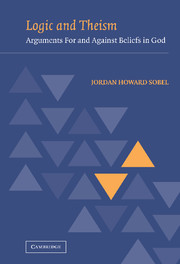Book contents
- Frontmatter
- Contents
- Preface
- DIVINITY
- ARGUMENTS FOR THE EXISTENCE OF GOD
- II Classical Ontological Arguments
- III Modern Modal Ontological Arguments
- IV Kurt Gödel's Ontologischer Beweis
- V First Causes “The Second Way”
- VI Ultimate Reasons: Proofs a contingentia mundi
- VII Look ’Round! – Arguments from Design
- VIII Clouds of Witnesses – “Of Miracles”
- ON TWO PARTS OF THE COMMON CONCEPTION
- ARGUMENTS AGAINST THE EXISTENCE OF GOD
- PRACTICAL ARGUMENTS FOR AND AGAINST THEISTIC BELIEFS
- Notes
- References
- Index of Names
II - Classical Ontological Arguments
Published online by Cambridge University Press: 28 July 2009
- Frontmatter
- Contents
- Preface
- DIVINITY
- ARGUMENTS FOR THE EXISTENCE OF GOD
- II Classical Ontological Arguments
- III Modern Modal Ontological Arguments
- IV Kurt Gödel's Ontologischer Beweis
- V First Causes “The Second Way”
- VI Ultimate Reasons: Proofs a contingentia mundi
- VII Look ’Round! – Arguments from Design
- VIII Clouds of Witnesses – “Of Miracles”
- ON TWO PARTS OF THE COMMON CONCEPTION
- ARGUMENTS AGAINST THE EXISTENCE OF GOD
- PRACTICAL ARGUMENTS FOR AND AGAINST THEISTIC BELIEFS
- Notes
- References
- Index of Names
Summary
There's no getting blood out of a turnip.
Captain MarryatINTRODUCTION
On ‘the very idea of an ontological proof’
1.1.1. Ontological arguments would be demonstrations of God's existence, deductions from scratch without aid of contingent premises. But cannot such existence proofs be rejected out of hand and without detailed consideration on the general ground that it is not possible to demonstrate the existence of anything? This has been said.
Cleanthes: [T]here is an evident absurdity in pretending to demonstrate a matter of fact, or to prove it by any arguments a priori. Nothing is demonstrable unless the contrary implies a contradiction. Whatever we conceive as existent, we can also conceive as non-existent. There is no being, therefore, whose non-existence implies a contradiction. Consequently there is no being whose existence is demonstrable. I propose this as entirely decisive.
(Hume 1991, Part 10, p. 149)However, while certainly nothing is demonstrable that is not itself necessary, it does not follow from that that there is nothing whose existence is demonstrable, for there are things that exist necessarily. For example, the number 23: It is necessary that there exists a prime number greater than 20 and less than 25, and it is 23. “But surely,” Cleanthes might complain, “you quibble. For no one supposes that God is a number, or anything like one.
- Type
- Chapter
- Information
- Logic and TheismArguments for and against Beliefs in God, pp. 29 - 80Publisher: Cambridge University PressPrint publication year: 2003



